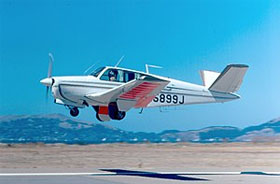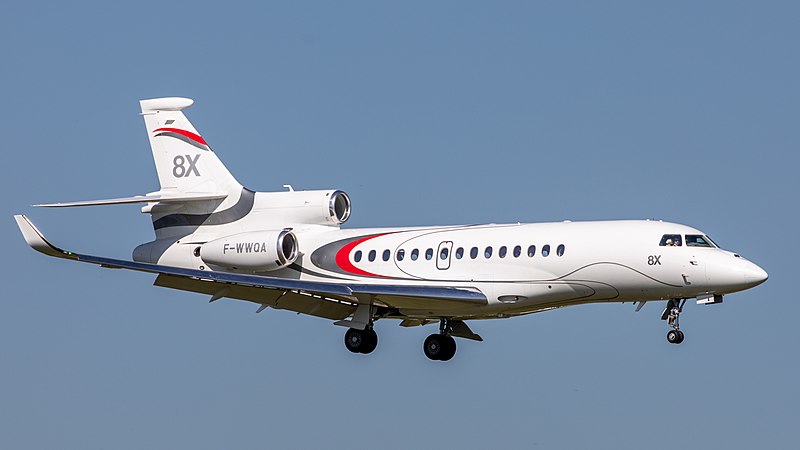 Walter Beech demonstrated both a love for, and an innate skill and understanding of aviation from a very early age. For example, in 1905, at the age of 14, he built and flew his first aircraft, a glider of his own design. This was followed by a stint in the U.S. Army Air Corps during World War I. After the war, he spent several years barnstorming throughout the Midwest. In 1921, he accepted a job with the Swallow Airplane Corporation as a test pilot and later became the general manager. The Swallow TP was the company’s primary aircraft model. It was a two-place, a metal-framed, fabric-covered biplane used primarily for flight training.
Walter Beech demonstrated both a love for, and an innate skill and understanding of aviation from a very early age. For example, in 1905, at the age of 14, he built and flew his first aircraft, a glider of his own design. This was followed by a stint in the U.S. Army Air Corps during World War I. After the war, he spent several years barnstorming throughout the Midwest. In 1921, he accepted a job with the Swallow Airplane Corporation as a test pilot and later became the general manager. The Swallow TP was the company’s primary aircraft model. It was a two-place, a metal-framed, fabric-covered biplane used primarily for flight training.
In 1924, Beech, along with Lloyd Stearman and Clyde Cessna, created the Travel Air Company. In 1929, while at Travel Air, Beech designed the Travel Air cabin plane that would meet National Air Transport specifications for a passenger plane. It soon became the standard for airmail transportation. Shortly thereafter, Travel Air merged with Curtis Wright. Beech became the vice president, and later, the president of the new company. His executive duties kept busy traveling and away from the production plant which is where he really wanted to be.
In the span of 27 years, Beech had taken his early interest in aviation and used his experience in both aviation and manufacturing to understand the emerging business of flying, designing, and building aircraft as well as running a successful aircraft manufacturing company

Beech Model 17R Staggerwing, Beechcraft Museum Tullahoma, Tennessee. A total of 785 Staggerwings were delivered.
Wanting to be more in touch with aircraft design and construction, he resigned from Travel Air in 1932 and established the Beech Aircraft Company. His wife Olive Ann, whom he had married two years earlier, became the new company’s secretary-treasurer. From the beginning, Beech began to set construction and performance standards for aircraft that exceeded that of most of his contemporaries.
Beech immediately set specific performance goals for the first of several iconic aircraft that would become associated with the Beech name. The goal was to build a luxurious five-seat aircraft with a top speed of 200 mph, with a landing speed of no more than 60 mph, and a range of 1,000 miles. It had to have sound aerodynamic characteristics and be easy to fly. Working to achieve these goals, Beech designed, built, and flew the first Model 17 in 1932. While the prototype performed well, two years of modifications and redesign efforts were required before the first Model 17R satisfied Beech and the aircraft was ready for market.

Beech Model 17 Staggerwing, Beechcraft Museum Tullahoma, Tennessee. Staggerwings were produced from 1933 – 1949.
The most significant design element of the Model 17 was the negative staggered wing design, where the top wing was set back from the lower wing, giving it its most recognized name, the “Beech Staggerwing.” The wing “stagger” improved flight control at all speeds. The aircraft also had retractable landing gear—that reduced drag and contributed to its speed, and also made the aircraft safer in the event of a belly landing.
Priced between $14,000 and $17,000, Beech sold only 18 aircraft in 1933 in the immediate years after the Great Depression. Each aircraft was hand crafted and the luxurious five-seat cabin was trimmed in leather. Over its production life, buyers had several radial engine options ranging 350 to more than 600 horsepower. Both fixed gear and retractable landing gear were available.
Many pilots achieved headlining performances in their Staggerwings: In 1934, one was flown around the world by pilots Farquhar and Beiler, and in 1939 Arlene Davis placed fourth in the 2,042-mile Bendix Trophy Race completing the trip in 8:42 at an average speed of 231 mph. The high standards that Beech insisted on are demonstrated by the many Beech Staggerwings still airworthy today.
The second iconic Beech aircraft rolled off the production line in 1937—the Beach Model 18, commonly called the “Twin Beech.” More than 9,000 Twin Beech aircraft were continuously produced over a span of 32 years. More than 4,500 served in World War II as light transports and trainers. It was even used as a light bomber by China. After the end of the war, many Twin Beech aircraft became commercial airline aircraft serving as commuter and regional airlines well into the 1970s. Others were converted to richly appointed corporate aircraft for many businesses.
Walter Beach became seriously ill in 1940, and his wife, Olivia Ann Beech took over management of the company during the 1940s, securing more than $80 million to expand the company for war production. The company produced more than 7, 400 aircraft of different models during WWII.
After the war, Olivia Beech remained in control of Beech. In 1947, Beech continued its line of iconic aircraft with the launch of the single-engine Beech Model 35 Bonanza that had the distinctive “V-tail.” Walter Beech died of a heart attack in 1950, but the Beech legacy continues to this day. The Bonanza line has become longest running aircraft production program in history.
The V-tail version of the Bonanza was in continuous production from 1947 through 1882. In 1952, Beech introduced the Debonair, which was the Model 35 with a conventional tail. This aircraft was later renamed the Bonanza. Today’s six-seat, 300 horsepower Model 36 Bonanza can trace it lineage back to the original 1937 Bonanza.
I n 1980, Raytheon purchased Beech Aircraft, Olivia Beech remained chairman of the board until 1962. Olivia Beech was awarded the Wright Brothers Memorial Trophy (1980) and inducted into the National Aviation Hall of Fame in 1981. She died in 1993 in Wichita, Kansas.

Beech Model 35 V-Tailed Bonanza – More than 17,000 Bonanzas in all variants have been produced. (Note optional Weather Radar dome on Right Wing), Beechcraft Museum Tullahoma, Tennessee.
The Walter and Olivia Beech legacy continues today having survived mergers and sales including Raytheon (1980), Hawker Beechcraft (1994), and as the Beechcraft Corporation (after Hawker Beechcraft went bankrupt in 2012). It was not until after the company was purchased by Raytheon that Olivia Beech stepped down as chairman of the board.
Beechcraft continued to produce the Bonanza, Baron, King Air as well as T-6 and AT-6 military trainers. In 2014, the Beechcraft Corporation was purchased by Textron, which had already purchased Cessna Aircraft Company in 1992. Textron has kept the two aircraft brands separate.
Over the history of the company, Beech Aircraft and Beechcraft have produced more 25 models of aircraft, including target drones for the military.

